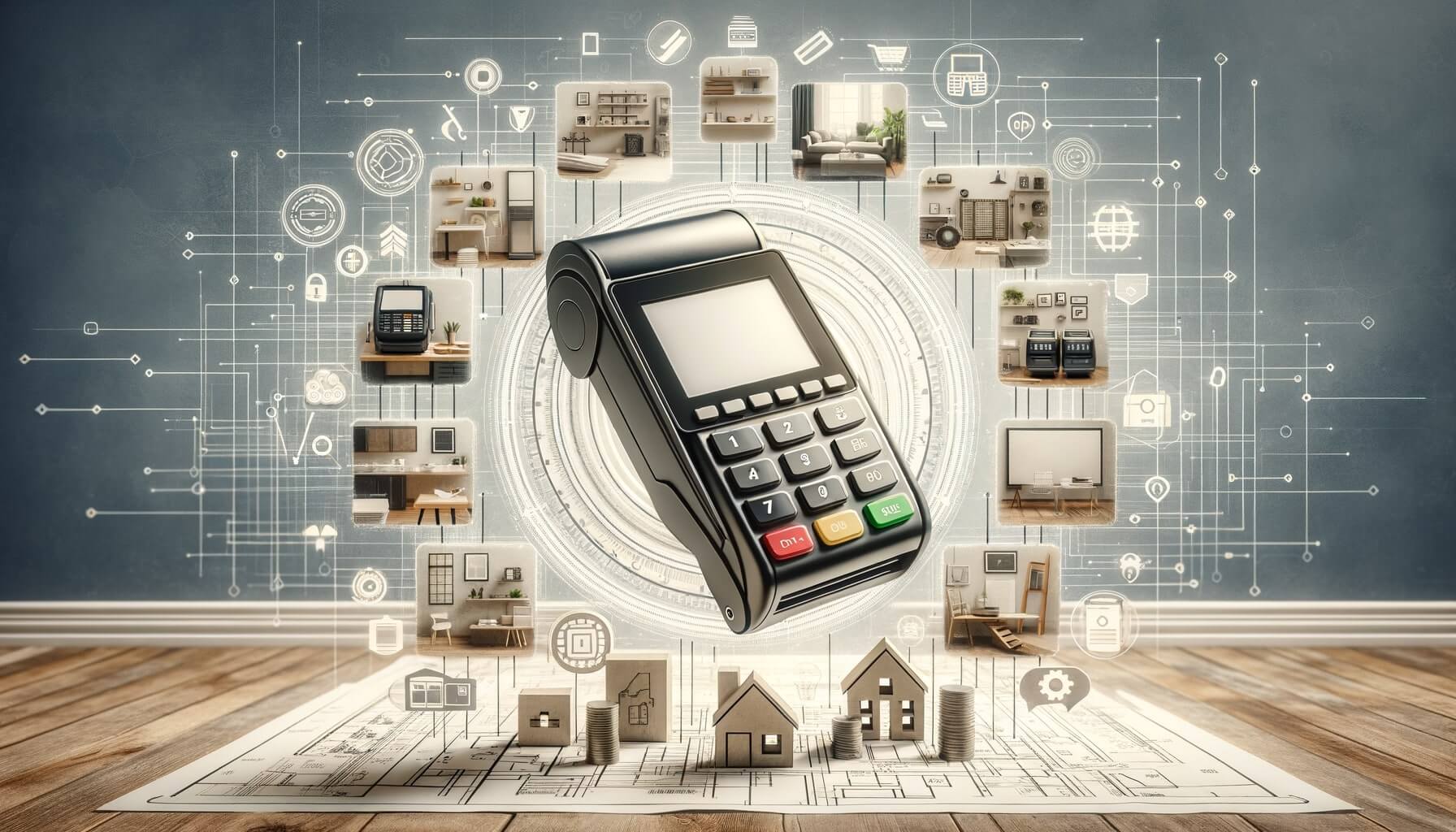
By alphacardprocess February 3, 2025
In today’s fast-paced digital world, technology has become an integral part of every industry, including the home renovation sector. One of the most significant advancements in technology for home renovation contractors is the introduction of mobile point-of-sale (POS) systems. These systems have revolutionized the way contractors manage their businesses, streamline operations, and enhance customer experience.
In this comprehensive guide, we will explore the benefits of using a mobile POS system for home renovation contractors, how to choose the right system for your business, and provide a step-by-step guide to setting up your mobile POS system.
Benefits of Using a Mobile POS System for Home Renovation Contractors

1. Increased Efficiency: A mobile point-of-sale (POS) system allows contractors to streamline their operations by eliminating the need for manual paperwork and reducing administrative tasks. Contractors can easily create and manage invoices, track project progress, and communicate with clients and team members, all from the convenience of their mobile device.
2. Improved Cash Flow: With a mobile POS system, contractors can accept payments on the spot, eliminating the need to wait for checks to clear or invoices to be processed. This improves cash flow and ensures timely payments, which is crucial for the financial stability of any business.
3. Enhanced Customer Experience: Mobile point-of-sale (POS) systems enable contractors to provide a seamless and personalized customer experience. Contractors can easily access client information, project details, and communicate with clients in real-time, ensuring that their needs are met promptly and efficiently.
4. Real-Time Inventory Management: Integrating inventory management with a mobile POS system allows contractors to track and manage their inventory in real-time. This ensures that contractors have the necessary materials and supplies for each project, reducing delays and improving project timelines.
5. Data Analytics and Reporting: Mobile point-of-sale (POS) systems provide contractors with valuable insights into their business performance. Contractors can analyze sales data, track project profitability, and identify areas for improvement, enabling them to make informed business decisions and optimize their operations.
Choosing the Right Mobile POS System for Your Home Renovation Business

When selecting a mobile POS system for your home renovation business, it is essential to consider your specific needs and requirements. Here are some factors to consider:
1. Compatibility: Ensure that the mobile point-of-sale (POS) system you choose is compatible with your existing devices, such as smartphones or tablets. It should also integrate seamlessly with other software or tools you use, such as accounting software or project management platforms.
2. Features: Different mobile POS systems offer various features, so it is crucial to assess which ones are essential for your business. Some common features to look for include invoicing, inventory management, payment processing, and reporting capabilities.
3. Integration Capabilities: Consider whether the mobile point-of-sale (POS) system can integrate with other software or tools that you use in your business, such as accounting software or project management tools.
4. Security: Since mobile POS systems handle sensitive customer information and financial transactions, security should be a top priority. Ensure that the system you choose has robust security measures in place, such as encryption and secure payment gateways.
5. Cost: Consider the cost of the mobile point-of-sale (POS) system, including any upfront fees, monthly subscriptions, and transaction fees. Compare different options to find the one that offers the best value for your business.
Setting Up Your Mobile POS System: Step-by-Step Guide
Now that you have chosen the right mobile POS system for your home renovation business, it’s time to set it up. Follow this step-by-step guide to get started:
1. Gather Necessary Information: Collect all the necessary information about your business, such as client details, project information, and inventory data. This will help you set up your mobile point-of-sale (POS) system accurately.
2. Install the Mobile POS App: Download and install the mobile POS app on your mobile device from the respective app store. Ensure that you have a stable internet connection.
3. Create an Account: Launch the mobile POS app and create an account using your business information. This will include your business name, contact details, and any other required information.
4. Customize Settings: Customize the settings of your mobile POS system according to your business needs. This may include setting up tax rates, payment options, and invoice templates.
5. Add Inventory: Enter your inventory data into the mobile point-of-sale (POS) system. This includes the products or materials you use for your projects, along with their prices and quantities.
6. Set Up Payment Processing: Connect your mobile POS system to a payment processor to accept credit card payments. Ensure that the payment processor is secure and reliable.
7. Create Invoices: Use the mobile point-of-sale (POS) system to create and send invoices to your clients. Customize the invoice templates with your business logo and branding.
8. Track Project Progress: Utilize the project management features of your mobile POS system to track the progress of each project. This includes assigning tasks, setting deadlines, and communicating with team members.
9. Generate Reports: Take advantage of the reporting capabilities of your mobile point-of-sale (POS) system to generate sales reports, project profitability reports, and other relevant data. Analyze these reports to gain insights into your business performance.
10. Train Your Team: If you have a team of contractors or employees, provide them with training on how to use the mobile POS system effectively. Ensure that they understand the features and functionalities and can utilize them to streamline their work.
Integrating Inventory Management with Your Mobile POS System

Inventory management is a critical aspect of any home renovation business. Integrating inventory management with your mobile point-of-sale (POS) system can help you streamline operations, reduce costs, and improve customer satisfaction. Here are some steps to integrate inventory management with your mobile POS system:
1. Choose an Inventory Management System: Select an inventory management system that is compatible with your mobile POS system. Look for features such as real-time inventory tracking, automatic reordering, and barcode scanning capabilities.
2. Sync Inventory Data: Once you have chosen an inventory management system, sync it with your mobile POS system. This will ensure that inventory levels are updated in real-time, and any changes made through the point-of-sale (POS) system are reflected in the inventory management system.
3. Set Reorder Points: Determine the minimum inventory levels for each item and set reorder points in your inventory management system. When inventory levels reach these points, the system will automatically generate purchase orders or alerts, ensuring that you never run out of essential materials.
4. Barcode Scanning: Utilize barcode scanning capabilities to streamline the inventory management process. This allows you to quickly and accurately track inventory levels, reduce errors, and improve efficiency.
5. Track Usage and Costs: Use your mobile POS system to track the usage of materials and associated costs for each project. This data can help you identify trends, optimize inventory levels, and make informed purchasing decisions.
6. Generate Reports: Leverage the reporting capabilities of your mobile POS and inventory management systems to generate detailed reports on inventory levels, usage, costs, and profitability. These reports can provide valuable insights into your business operations and help you make data-driven decisions.
Accepting Payments and Managing Invoices with Your Mobile Point-of-Sale (POS) System

One of the primary benefits of a mobile POS system for home renovation contractors is the ability to accept payments on the spot and manage invoices efficiently. Here are some steps to help you accept payments and manage invoices with your mobile point-of-sale (POS) system:
1. Accepting Payments: With a mobile POS system, you can accept payments on the spot, whether it’s through credit cards, mobile wallets, or other payment methods. Ensure that your mobile POS system is securely connected to a payment processor to facilitate seamless transactions.
2. Generating Invoices: Use the mobile POS system to create professional-looking invoices for your clients. Customize the invoice templates with your business logo, contact information, and payment terms.
3. Sending Invoices: Send invoices to your clients directly from the mobile point-of-sale (POS) system via email or other communication channels. This ensures that your clients receive the invoices promptly and can make timely payments.
4. Tracking Payments: Keep track of payments received through the mobile POS system. The system should provide you with real-time updates on payment statuses, allowing you to follow up on any outstanding payments.
5. Automating Reminders: Set up automated reminders for overdue payments using the mobile POS system. This saves you time and effort in manually following up with clients and ensures that you receive payments on time.
Streamlining Project Management with a Mobile POS System
A mobile POS system can act as a powerful tool for streamlining project management tasks, ensuring that projects stay on track and within budget. Here are some ways you can leverage your mobile point-of-sale (POS) system for efficient project management:
1. Task Assignment: Use the project management features of your mobile POS system to assign tasks to your team members. This ensures that everyone knows their responsibilities and deadlines.
2. Real-Time Communication: Utilize the communication features of the mobile point-of-sale (POS) system to stay in touch with your team members and clients in real-time. This allows for quick decision-making, problem-solving, and progress updates.
3. Document Management: Store project-related documents, such as contracts, permits, and design plans, in the mobile POS system. This ensures that all relevant information is easily accessible to team members and clients.
4. Time Tracking: Track the time spent on each project using the mobile POS system. This helps you accurately calculate project costs, monitor productivity, and ensure that projects are completed within the allocated time frame.
5. Progress Tracking: Monitor the progress of each project using the project management features of the mobile point-of-sale (POS) system. This includes tracking milestones, deadlines, and any changes or updates to the project scope.
Enhancing Customer Experience with a Mobile POS System
Providing an exceptional customer experience is essential for the success and growth of any home renovation business. Here’s how a mobile POS system can help enhance customer experience:
1. Personalized Service: With a mobile POS system, you can access client information, project details, and communication history in one place. This allows you to provide personalized service to your clients, addressing their specific needs and preferences.
2. Real-Time Updates: Keep your clients informed about the progress of their projects in real-time. Use the mobile point-of-sale (POS) system to send updates, photos, and videos, ensuring that your clients are always in the loop.
3. Prompt Responses: Utilize the communication features of the mobile POS system to respond to client inquiries and requests promptly. This demonstrates your professionalism and commitment to customer satisfaction.
4. Easy Payment Options: Accepting payments through the mobile POS system provides convenience to your clients. They can make payments using their preferred method, whether it’s credit cards, mobile wallets, or other payment options.
5. Post-Project Follow-Up: Use the mobile point-of-sale (POS) system to send post-project surveys or follow-up emails to your clients. This allows you to gather feedback, address any concerns, and maintain a positive relationship with your clients.
Troubleshooting Common Issues with Mobile POS Systems
While mobile POS systems offer numerous benefits, it’s essential to be aware of common issues and how to troubleshoot them. Here are some common issues and their solutions:
1. Connectivity Issues: If you experience connectivity issues with your mobile POS system, ensure that you have a stable internet connection. If the issue persists, contact your mobile point-of-sale (POS) system provider for assistance.
2. Software Updates: Regularly update your mobile POS system to ensure that you have the latest features and security patches. Check for updates in the app store or contact your mobile POS system provider for guidance.
3. Hardware Compatibility: If you encounter hardware compatibility issues, ensure that your mobile device meets the system requirements of the mobile POS app. If necessary, consult with the mobile point-of-sale (POS) system provider for compatible hardware options.
4. Payment Processing Errors: If you experience payment processing errors, ensure that your mobile POS system is securely connected to a payment processor. Verify that the payment processor is functioning correctly and contact their support team for assistance if needed.
5. Data Backup: Regularly back up your data to prevent loss in case of device failure or other unforeseen circumstances. Most mobile point-of-sale (POS) systems offer data backup options within the app or provide guidance on how to back up your data externally.
FAQs
Q1. What is a mobile Point-of-Sale (POS) system?
A mobile Point-of-Sale (POS) system is a portable device that allows contractors to accept payments, manage invoices, track inventory, and streamline project management tasks, all from the convenience of their smartphones or tablets.
Q2. How can a mobile POS system benefit home renovation contractors?
A mobile Point-of-Sale (POS) system can benefit home renovation contractors in several ways. It increases efficiency, enhances the customer experience, improves cash flow, enables accurate inventory management, and streamlines project management tasks.
Q3. How do I choose the right mobile POS system for my home renovation business?
When choosing a mobile POS system, consider factors such as compatibility, features, user-friendliness, security, and cost. Assess your specific needs and requirements to ensure that the system aligns with your business goals.
Q4. How do I set up a mobile POS system for my home renovation business?
To set up a mobile point-of-sale (POS) system, research and choose a system that meets your needs, purchase the necessary hardware, install the mobile POS app, customize settings, add inventory, test the system, train your team, and integrate with other tools.
Q5. How can I integrate inventory management with my mobile POS system?
To integrate inventory management with your mobile POS system, choose a compatible inventory management system, sync inventory data, set reorder points, utilize barcode scanning, track usage and costs, and generate reports.
Q6. How can I accept payments and manage invoices with my mobile POS system?
To accept payments and manage invoices with your mobile point-of-sale (POS) system, choose a payment processor, set up payment options, generate professional invoices, customize invoices, send invoices, accept payments, track payments, and automate reminders.
Q7. How can I streamline project management with a mobile POS system?
To streamline project management with a mobile POS system, centralize project information, access information on the go, track project progress, monitor budgets and expenses, communicate with clients, collaborate with team members, generate project reports, and analyze data for continuous improvement.
Conclusion
In conclusion, mobile POS systems have become an invaluable tool for home renovation contractors. They offer numerous benefits, including increased efficiency, improved cash flow, enhanced customer experience, and streamlined project management.
By choosing the right mobile point-of-sale (POS) system for your business, setting it up correctly, and integrating inventory management and payment processing, you can take your home renovation business to new heights. Remember to troubleshoot common issues and continuously explore new features and functionalities offered by your mobile POS system to stay ahead of the competition and provide exceptional service to your clients.